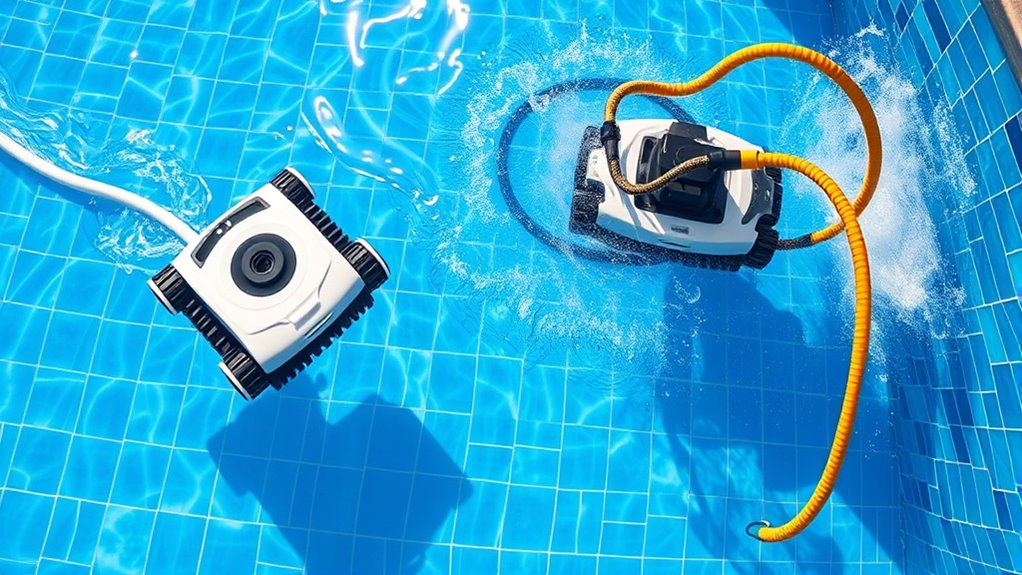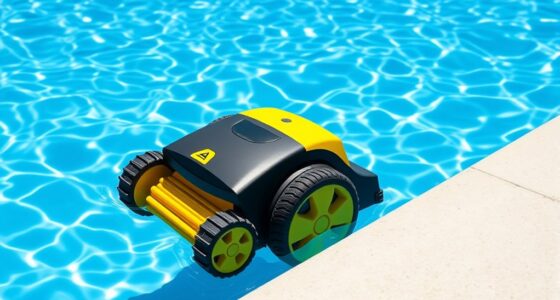Suction pool cleaners connect to your skimmer or vacuum line and use the pool’s pump to pull debris into a filter bag, making them simple and energy-efficient. Pressure cleaners rely on water pressure from your pump or booster, covering larger areas faster but needing more setup and higher energy use. Each type has its advantages and drawbacks; explore further to find the best fit for your pool’s size and needs.
Key Takeaways
- Suction cleaners connect directly to skimmers, using pool pump suction, while pressure cleaners rely on water pressure from the pump system.
- Suction cleaners are better at cleaning fine debris and tight spots, whereas pressure cleaners excel at removing larger debris and covering large areas quickly.
- Suction models are generally easier to install, more affordable, and energy-efficient; pressure cleaners require additional equipment and have higher costs.
- Pressure cleaners dislodge stubborn debris more effectively from the pool floor but may need more maintenance and power consumption.
- Both types contribute to deep cleaning, but suction cleaners are superior at cleaning corners, while pressure cleaners cover larger surface areas faster.
How Suction and Pressure Pool Cleaners Work
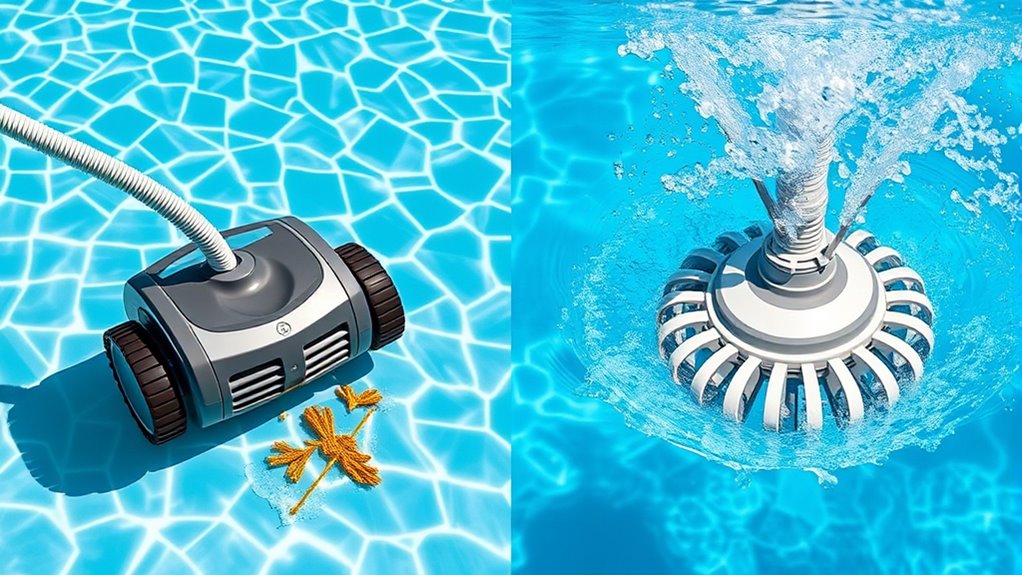
Suction and pressure pool cleaners operate using different mechanisms to keep your pool clean. Suction cleaners use a hose connected to your skimmer or dedicated vacuum port, creating a strong vacuum that pulls debris into a filter bag. Their design variations often include lightweight, maneuverable units with simple technology integrations, making them easy to operate. On the other hand, pressure cleaners rely on water pressure from your pool’s pump to propel themselves around the pool surface. They feature unique design variations like tire treads or rotating brushes, and incorporate technology integrations such as adjustable jets or steering mechanisms. These differences allow each type to target specific debris and surface types effectively, giving you options based on your pool’s shape, size, and cleaning needs. Additionally, understanding water flow dynamics can help you optimize your pool’s filtration system for better cleaning performance and energy efficiency during operation, especially considering the types of pool cleaners available. Properly managing water flow can maximize cleaning efficiency and prolong the lifespan of your pool equipment.
Installation and Setup Differences

Setting up your pool cleaner varies depending on the type you choose, with some requiring more effort than others. You’ll need to take into account how complex the installation process is and whether your equipment is compatible. Knowing these differences helps ensure a smooth setup from the start. For instance, Mazda Tuning can involve various modifications that enhance performance and aesthetics, similar to customizing your pool cleaner for optimal efficiency. Additionally, verifying the trustworthiness of your brand can provide peace of mind during installation, ensuring you select reliable products that will perform effectively over time. Proper tuning techniques, akin to GMC tuning, can optimize your equipment’s efficiency and longevity, making the setup process smoother and more effective. Being aware of data privacy challenges in automation can also help you choose systems that prioritize security, leading to a safer and more reliable operation. Furthermore, understanding the sound healing science behind certain features may help you select a cleaner that operates more quietly and effectively.
Setup Complexity Variations
The installation and setup process for pool cleaners can vary considerably between suction and pressure models, affecting how easily you can get your system up and running. Suction cleaners generally require simple manual operation, connecting directly to your skimmer or dedicated suction line. Pressure cleaners often involve more complex setup, including attaching hoses and fittings, which can be more time-consuming. Additionally, water flow requirements differ between the two types, influencing overall system performance and setup considerations. Proper installation procedures ensure optimal operation and longevity of your cleaner. Key differences include:
- Suction cleaners are straightforward, with minimal setup, ideal for quick installation.
- Pressure cleaners may need hose extension and additional fittings, increasing complexity.
- Automatic scheduling features are typically easier to implement with suction models, while pressure cleaners may require manual operation for some functions.
Furthermore, understanding the water flow dynamics involved helps in selecting the most suitable cleaner for your pool’s specific needs. Ensuring correct water flow adjustment can improve cleaning efficiency and prevent damage to your equipment. Your choice impacts how much effort and time you’ll spend on setup and ongoing maintenance.
Equipment Compatibility Needs
Choosing the right pool cleaner depends heavily on your existing equipment, as compatibility varies between models. With suction and pressure pool cleaners, you need to take into account your pool equipment to ensure proper operation. Some models require specific fittings or hoses that match your skimmer or dedicated cleaner port, which can lead to compatibility issues if they don’t align. For example, pressure cleaners often need a dedicated return line or booster pump, while suction cleaners connect directly to the skimmer. Before purchasing, review your pool setup carefully. Failing to check compatibility can result in poor cleaning performance or damage to your equipment. Taking the time to verify that your pool equipment supports the cleaner you choose helps ensure smooth installation and effective operation. Additionally, understanding your system compatibility can help prevent potential issues and maximize the efficiency of your pool cleaning system. Ensuring your pool’s equipment setup aligns with the cleaner’s requirements can also reduce troubleshooting time later on. Being aware of your pool’s filter type is also crucial, as certain cleaners work better with specific filtration systems. Moreover, considering the water flow rate of your system can significantly impact the cleaner’s performance and lifespan. Knowing the hose length required for your setup ensures coverage of the entire pool without limitations.
Cleaning Performance and Effectiveness
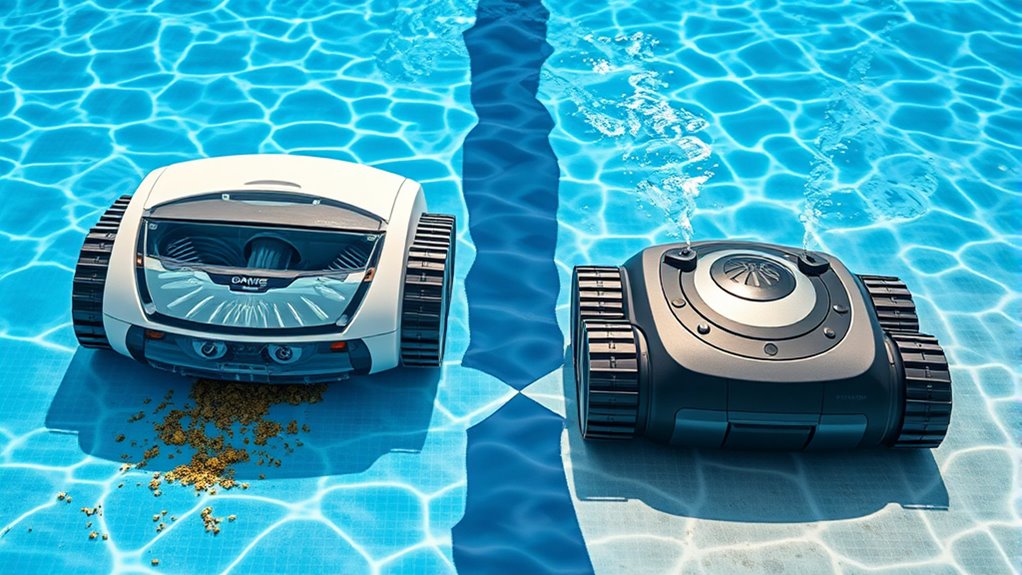
When it comes to cleaning performance, your main focus should be on how well the cleaner collects debris, covers the pool surface, and handles deep cleaning. You’ll want to contemplate if the device efficiently picks up dirt without missing spots and whether it can reach hidden areas. Understanding these points helps you choose a cleaner that keeps your pool spotless and well-maintained. Additionally, the effectiveness of the cleaning device can be enhanced by considering features like advanced technology incorporated into some models. Incorporating personal and community resilience strategies from emergency preparedness can also help in maintaining your pool equipment during power outages or extreme weather events. For example, selecting a robust and reliable cleaner ensures consistent operation even in challenging conditions. Moreover, considering the material quality of the patches can influence their durability and skin compatibility, ensuring a more effective and comfortable treatment.
Debris Collection Efficiency
Suction and pressure pool cleaners differ considerably in how effectively they collect debris, impacting overall cleaning performance. Suction cleaners excel at removing fine particles and small debris, making them ideal for thorough cleaning. Pressure cleaners, on the other hand, handle larger debris better but may miss finer dirt. This difference affects not only cleaning efficiency but also energy consumption and environmental impact.
Consider these points:
- Suction cleaners often use less energy, reducing environmental impact
- Pressure cleaners may consume more power due to stronger pumps
- Debris collection efficiency influences how often you need to manually clean filters or baskets
Choosing the right cleaner depends on your debris type and environmental considerations, ensuring ideal cleaning with minimal energy use.
Surface Coverage Area
Surface coverage area substantially influences a pool cleaner’s overall effectiveness, as it determines how much of your pool is cleaned during each session. A cleaner with a larger surface area or higher coverage capacity can efficiently navigate and clean more space in less time. Suction cleaners typically excel in covering tight spots and edges, but their coverage capacity may be limited, affecting overall surface area cleaned. Pressure cleaners often have a broader coverage capacity, allowing them to cover larger areas quickly. Your choice depends on your pool’s size and shape; a greater coverage capacity ensures you spend less time cleaning and more time enjoying your pool. Remember, the surface area a cleaner can handle directly impacts its ability to maintain a consistently clean pool.
Deep Cleaning Capabilities
Deep cleaning performance directly impacts how well your pool stays pristine over time. Both suction and pressure cleaners excel in different areas of cleaning effectiveness, but their deep cleaning capabilities depend on several factors. Suction cleaners often excel at removing dirt from tight corners, while pressure cleaners are better at dislodging stubborn debris from the pool floor. To maximize cleaning, consider chemical compatibility to prevent damage to pool surfaces and guarantee operator safety during maintenance.
- Effectively targets stubborn debris and algae buildup
- Maintains chemical balance without surface damage
- Ensures safe operation with minimal risk to users and equipment
Maintenance and Durability
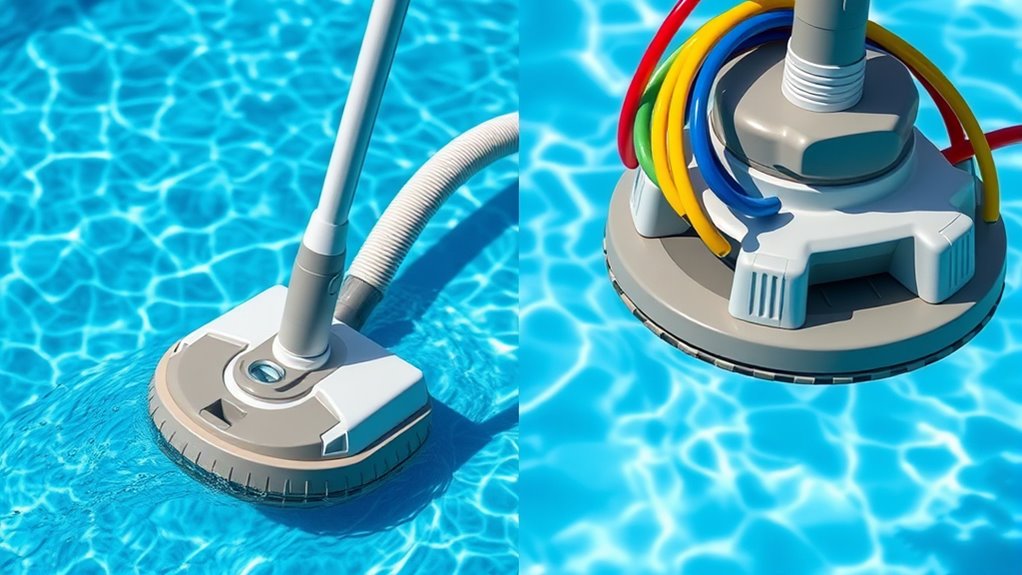
While both suction and pressure pool cleaners are designed for regular use, their maintenance and durability can vary considerably. Suction cleaners generally have longer filter lifespans, but they require regular filter cleaning to prevent clogs. Pressure cleaners depend on motor performance; therefore, motor maintenance is vital for longevity.
| Aspect | Suction Cleaner | Pressure Cleaner |
|---|---|---|
| Filter Lifespan | Longer, requires cleaning | Shorter, needs frequent replacement |
| Motor Maintenance | Less intensive, fewer parts involved | Regular checks needed for pump motor |
| Durability | Typically more durable over time | Can wear faster if not maintained |
Proper upkeep ensures both types last, but understanding their maintenance needs can help you make the most of your investment.
Cost and Budget Considerations
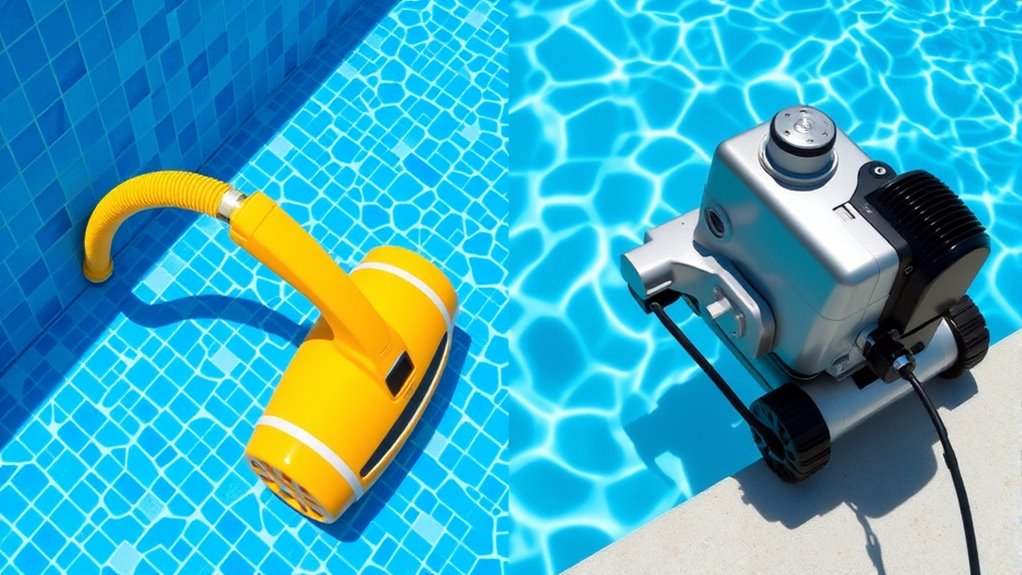
When choosing between suction and pressure pool cleaners, your budget plays a significant role. Budget constraints influence your decision, especially when considering the cost comparison of each system. Suction cleaners generally have a lower initial cost, making them appealing if you’re on a tight budget. Pressure cleaners tend to be more expensive upfront but may offer longer-term savings through efficiency. Keep in mind:
- Upfront purchase price
- Installation and maintenance costs
- Long-term operational expenses
Pros and Cons of Each System
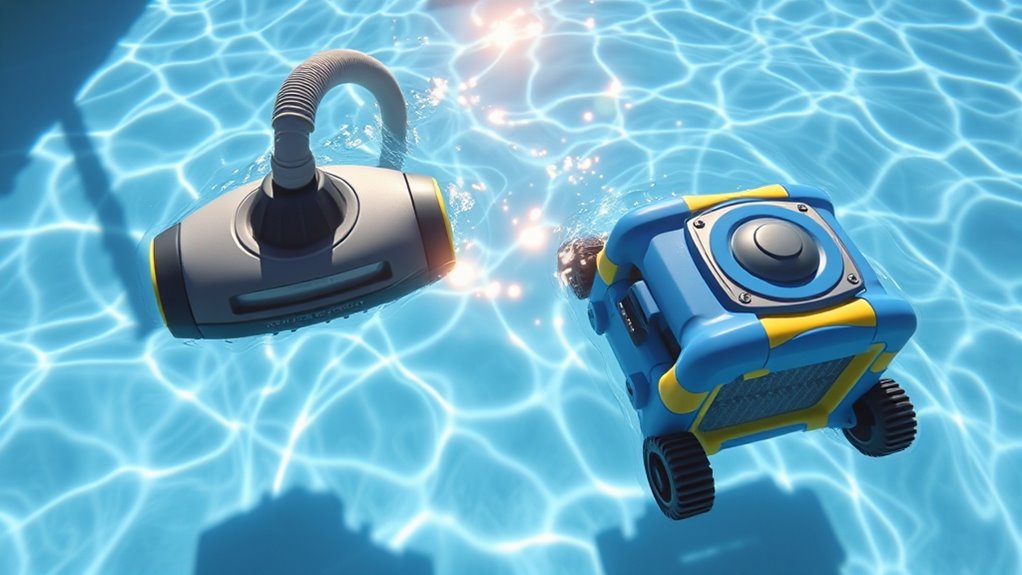
Suction and pressure pool cleaners each have distinct advantages and disadvantages that can influence your choice. For smaller pools, suction cleaners often provide a simple, cost-effective solution with minimal setup, enhancing user experience. They are typically easier to operate and maintain, making them ideal for pool size. However, they may struggle with larger pools or complex shapes, limiting cleaning efficiency. Pressure cleaners excel in larger or more intricate pools, offering thorough cleaning due to their powerful jets. They often cover more surface area quickly, improving user experience for bigger pools. On the downside, pressure systems can be more complex to install and maintain, and may require additional infrastructure like booster pumps. Your pool size and desired user experience should guide your decision between these two systems.
Frequently Asked Questions
Which Pool Cleaner Type Is Better for Large or Irregular Pools?
For large or irregular pools, choosing the right cleaner depends on your pool size and shape. Pressure pool cleaners excel in covering expansive areas and maneuvering complex shapes, making them ideal for big or oddly-shaped pools. They use water pressure to propel themselves, ensuring thorough cleaning. Suction cleaners work well for smaller, simpler pools, but may struggle with irregular shapes. So, for larger or irregular pools, a pressure cleaner is usually your best bet.
Can Suction and Pressure Cleaners Operate Simultaneously?
Imagine your pool as a busy river, with debris flowing in from all directions. You wonder if dual operation, where suction and pressure cleaners work simultaneously, is possible. The answer is yes; many systems support simultaneous cleaning, enhancing efficiency. This dual operation allows your pool to be scrubbed and vacuumed at once, making maintenance quicker and more thorough, ensuring your pool stays pristine with less effort on your part.
How Do Environmental Factors Affect Cleaner Performance?
You should consider how environmental factors impact your cleaner’s performance. High chlorine levels can corrode parts and reduce efficiency, while low chlorine might allow algae buildup. Water temperature also matters; warmer water speeds up debris decay, making cleaning easier, but extreme heat can strain your cleaner. Keep an eye on these factors to guarantee ideal operation, helping your cleaner stay effective and prolong its lifespan.
Are There Specific Brands Recommended for Each Cleaner Type?
When choosing a cleaner, you might wonder about brand recommendations for suction or pressure types. For suction cleaners, brands like Pentair and Zodiac are reliable, while Polaris and Hayward excel in pressure models. Always follow maintenance tips, such as regular filter cleaning and inspecting hoses, to keep your chosen cleaner performing well. Research reviews and consult experts to ensure you select a model that fits your pool size and needs.
What Safety Precautions Are Necessary During Installation and Use?
Imagine giving your pool a gentle hug while installing your cleaner. During installation safety, you should turn off power and guarantee all connections are secure to prevent mishaps. User precautions include wearing gloves, avoiding electrical hazards, and keeping children and pets away during setup. Following proper procedures ensures a smooth, safe experience, protecting both you and your equipment while enjoying a spotless pool.
Conclusion
Choosing between suction and pressure pool cleaners is like picking the right tool for a job—you need what’s best for your needs. Both have their strengths and quirks, so weigh what’s most important—cost, maintenance, or cleaning power. Remember, the right cleaner isn’t just a gadget; it’s the loyal swimmer that keeps your pool sparkling. Make your decision wisely, and your pool will thank you with every gleaming ripple.
